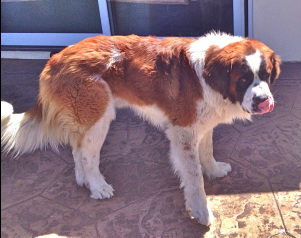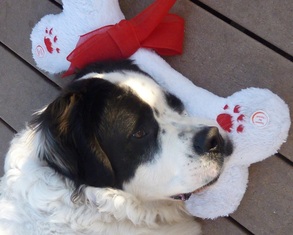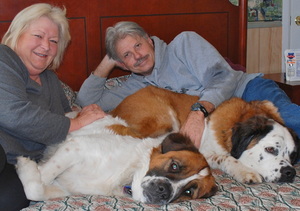
Springtime has sprung weeds, rather than roses, for some of our Sunny Saints. Last week, young Rosie from Napa went in for her spay surgery. As the good doctors at U.C. Davis were prepping her for surgery, they found a foxtail embedded in a pocket in her throat. Same day down south, new rescue Angus was in surgery having three foxtails removed from his paw.
Foxtail is a weed that grows in abundance in the west. As the weather warms, it starts to dry, turning from green to brown. The seed head drys, becoming stiff and sharp. It presents a very real danger to your Saint, working its barbs into any part of your dog, including the nose, toes, ears, eyes and mouth. And they don’t stop there. Once inside the dog’s body, foxtails will travel.
Dr. Laura Weatherford (Dr. Laura), of Tustin Santa Ana Veterinary Hospital is treating several dogs for foxtails right now. She confirmed that foxtails are a big problem in California, explaining that “Foxtails are arrow-shaped, and will only move in one direction. They can penetrate skin and tissue, migrating around the body causing bad infections and pain.”
According to Dr. Laura, these bad seeds are difficult to find and remove. One current patient has a small abscess between his toes. She probed while the dog was awake, but was unable to find a foxtail. She said sometimes surgery is necessary to explore the cause. Sometimes, the foxtail has just punctured the skin and caused an infection, but the dog was able to get it out before it got all the way in. She has another big dog that may have a foxtail under his tongue.
Foxtail Grass and Your Dog, an article on WebMD.com, recommends checking for foxtails or contacting your vet if your Saint displays any of these symptoms:
The following links may be helpful:
http://news.ucdavis.edu/search/news_detail.lasso?id=4226 Foxtails Pose Autumn Threat to Dogs
http://pets.webmd.com/dogs/foxtail-grass-and-your-dog
As always, please share any tips or comments that may be useful to others in the Sunny Saints family. If you post your comments here on the blog, rather than on Facebook, we will have an easier-to-find reference!
Foxtail is a weed that grows in abundance in the west. As the weather warms, it starts to dry, turning from green to brown. The seed head drys, becoming stiff and sharp. It presents a very real danger to your Saint, working its barbs into any part of your dog, including the nose, toes, ears, eyes and mouth. And they don’t stop there. Once inside the dog’s body, foxtails will travel.
Dr. Laura Weatherford (Dr. Laura), of Tustin Santa Ana Veterinary Hospital is treating several dogs for foxtails right now. She confirmed that foxtails are a big problem in California, explaining that “Foxtails are arrow-shaped, and will only move in one direction. They can penetrate skin and tissue, migrating around the body causing bad infections and pain.”
According to Dr. Laura, these bad seeds are difficult to find and remove. One current patient has a small abscess between his toes. She probed while the dog was awake, but was unable to find a foxtail. She said sometimes surgery is necessary to explore the cause. Sometimes, the foxtail has just punctured the skin and caused an infection, but the dog was able to get it out before it got all the way in. She has another big dog that may have a foxtail under his tongue.
Foxtail Grass and Your Dog, an article on WebMD.com, recommends checking for foxtails or contacting your vet if your Saint displays any of these symptoms:
- Feet. Foxtails love your dog's feet and can easily become embedded between tender toes. Check for foxtails if you notice swelling or limping or if your dog is constantly licking the area.
- Ears. If your pooch is shaking his head, tilting it to the side, or scratching incessantly at an ear, this could be the sign of a foxtail -- one that may be so deep inside the ear canal you can't see it. Your veterinarian needs to take a look using a special scope.
- Eyes. Redness, discharge, swelling, squinting, and pawing all may be signs your dog has a foxtail lodged in its eye. If you think this may be the case, seek veterinary care immediately.
- Nose. If you see discharge from the nose, or if your dog is sneezing frequently and intensely, there may be a foxtail lodged in a nasal passage.
- Vagina or penis. Foxtails can find their way into these areas too. So if you notice your dog persistently licking at its genitals, foxtails could be the cause.
The following links may be helpful:
http://news.ucdavis.edu/search/news_detail.lasso?id=4226 Foxtails Pose Autumn Threat to Dogs
http://pets.webmd.com/dogs/foxtail-grass-and-your-dog
As always, please share any tips or comments that may be useful to others in the Sunny Saints family. If you post your comments here on the blog, rather than on Facebook, we will have an easier-to-find reference!








 RSS Feed
RSS Feed